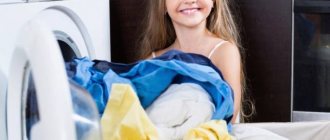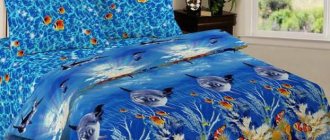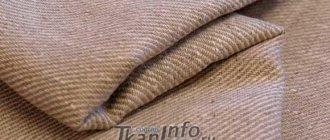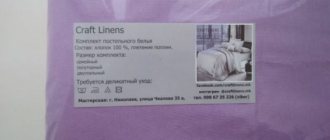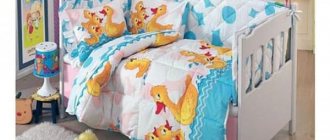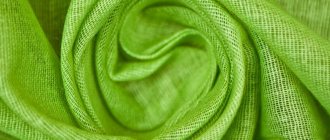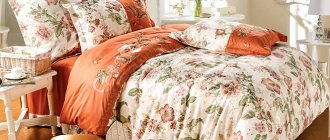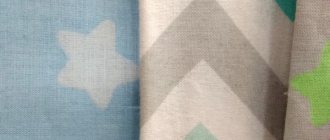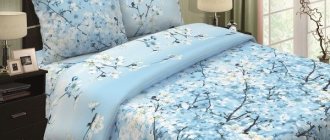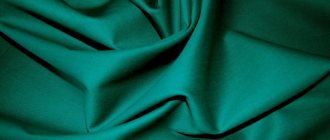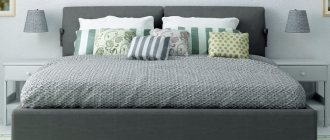Characteristics of children's fabrics
To arrange a children's bed, you should select high-quality materials. They must meet basic requirements.
- Be safe for the baby. Bedding should not emit harmful substances that can lead to dermatitis, allergic rashes, itchy skin and other problems. In the manufacture of such materials, chemically “aggressive” dyes should not be used.
- Possess hygroscopicity. Children often sweat during night or daytime sleep, so bedding fabric should absorb excess moisture well and dry quickly.
- Good air flow. Natural circulation will allow the skin to “breathe”, thereby creating favorable conditions for quality rest.
- Contribute to the absence of static accumulation.
- Differ in color fastness. Sometimes it happens that patterns from colorful and bright fabrics remain on the child’s skin after sleep. This shouldn't happen.
- Be comfortable. The bedding material should create a pleasant tactile sensation when in contact with the body.
- Have sufficient strength and wear resistance. The fact is that bedding in a child’s crib gets dirty much more often than in an adult’s. Therefore, it is important that the material can withstand more than a dozen washes while maintaining its original qualities.
- Easy to care for. This is an optional criterion. However, any parent will appreciate it if the fabric is easy to wash, dry quickly and smooth out without much effort.
An important selection criterion is the appearance of the fabric. Before falling asleep, many children look at the pictures on the duvet cover, pillowcase or sheet. Therefore, images on bedding should be unobtrusive, but attractive to children.
Types of children's bedding
If you thought that children's CPB is only for newborns, then you were mistaken. In fact, all sets of children's underwear can be divided into several types:
- Bed linen for the crib. This set of bedding is also called a “nursery”.
- For preschoolers . Suitable for beds for preschoolers and elementary school students.
- One and a half . This set is suitable for a teenager; the only thing that distinguishes it from the usual one-and-a-half set is the coloring.
Each size is suitable for children of a certain age. It is not a good idea to buy a set of bedding for a child that is larger than necessary, so to speak, for growth. In a large duvet cover, a small child may simply get confused or the blanket may get lost in it.
Choosing a sheet
A sheet is a rectangular piece of fabric that covers a mattress. This type of textile wears out quite quickly because it experiences more friction and withstands pressure. The sheet most often needs to be washed.
There are several types of sheets:
- An ordinary piece of fabric, processed on all four sides, is simply used to cover the mattress. It’s good if this item is larger than the size of the bed, so that all the edges can be tucked under the mattress - this way the sheet will hold well and will not bunch up or slide off.
- A sheet with an elastic band is ideal for a child's room. The product is very easy to attach to the bed thanks to the elastic tape that is sewn around the perimeter. The elastic prevents the sheet from coming off, and the child sleeps peacefully.
- A Velcro sheet is also a good option for a child's bed. However, be careful - Velcro clings to all fabrics during washing, but they perform their function - to stay on the bed - perfectly.
Standard bed sheet sizes:
- 110x150 cm (nursery bed);
- 120x150 cm (standard);
- 150x220 cm (schoolchildren and teenagers).
Sometimes fabrics for children's underwear are treated with special impregnations. If necessary, you can find not only antibacterial kits, but also products with waterproof treatment.
Contents and dimensions
Modern manufacturers offer three main options for bedding sets for a cradle:
- 3 pieces (sheet, pillowcase, duvet cover),
- 5 items (a soft side to the crib and a canopy are added),
- 6 or 7 items (including blanket, pillow).
Please note that the side can be one-piece (in one piece) or separate, but in the package it must be indicated as 1 item. A separate advantage is if the covers on the sides are removable, such as those from byTwinz.
The standard dimensions of a cradle mattress are 120x60, and you need to start from them when sewing and choosing a set. According to the standard, bedding for newborns includes a duvet cover 125x120 cm and a sheet 100x117 cm. As a rule, sheets 90x150 with elastic or 140-160x100 cm are on sale. The pillowcase is usually 40x60, for a standard non-orthopedic thin pillow .
If the blanket is included in the kit, it is usually filled with holofiber (the worst option), synthetic padding (preferable because it can withstand washing well, water - up to 40 ° C) and quilted.
Blankets also come in flannelette, wool, quilted and stuffed with wool or down, and there are also bamboo models. These accessories are usually sold separately. They have no particular advantages or disadvantages. I will only note that those stuffed with wool are heavy and relatively inflexible. Down ones are very warm and soft, they fit better to the body. Thick blankets are useful in the off-season, when the apartment is cold; the rest of the time there is no need for them.
Optional Accessories
These include the canopy and sides, which are stuffed with holofiber or padding polyester. The latter are needed for very active babies, whose legs regularly get stuck between the bars of the crib, and who squirm a lot, not yet being able to roll over, and slide their heads towards the fence. Disadvantages of the sides: they collect dust and block the view, making it difficult to explore the world around and see mom. Bored, the little one becomes capricious. In addition, as soon as the baby grows up, he will try to pull down the sides or learn to cling to them in order to hang himself over the fence - this is dangerous. As soon as the baby begins to sit, the sides must be removed.
The canopy today serves a purely decorative function and is more of a hindrance than a help. Mosquito nets on the windows reliably protect your baby from mosquitoes and flies at home. The canopy collects dust, impairs air circulation and prevents the child from exploring the world around him. As soon as the baby learns to control the handles and grab, he will begin to pull the canopy, risking the fabric and fastening falling on himself; less often, the crumbs grab the edge of the canopy and get entangled in it. If you still want to have a curtain over the crib, buy two at once and change them every other day, putting one in the wash, bend the edges during the day, giving your child a clear view.
Advice! To sew bedding for a cradle, take a roll 140 cm wide and cut it crosswise. It is more convenient to sew a duvet cover with one seam, in the center on the front side.
In fact, it is not so important for a newborn what to sleep on, because most often he is wrapped either in a vest and rompers, or in a diaper. What the baby needs much more is a well-rested, good mother and breast milk. And to give yourself more time to relax, don’t skimp on bedding. Take a high-quality set or material that is easy to wash and iron and which will retain its attractive appearance for a long time. And most importantly, love yourself and your baby.
Colors
When choosing a set of bed linen or fabric for a duvet cover, pillowcase or sheet, you should consider its color. Scientists have long proven that colors can influence a child’s psyche, mood and behavior.
When purchasing fabric for a baby's crib, it is better to choose products in soft pastel colors. White and milky shades will help calm and relax the child, ensuring that he quickly goes to sleep. Pale blue, soft pink and beige tones of bed linen will also “help you sleep.” It is important to note that the accessories should not have numerous bright images. It is better that the number of pictures is limited and their colors are light.
Bright colors such as green, red, orange, blue can energize children and give them energy. Due to these features, bedding with such shades is recommended for use in the beds of children who are already beginning to show interest in games.
When choosing fabric for a children's sleeping set, you should avoid purchasing materials in dark colors. Blue, black, purple, dark brown colors will cause a child to feel anxious.
Bed linen of such colors will not allow the baby to relax and fall asleep quickly.
Choose safe bedding for your child
In this article, we tried to touch on some of the most important aspects of choosing bedding for a child. These are material, size and color. But this is not all that is important to pay attention to when choosing children's bedding. Another important criterion is the safety of the bedding.
It seems that there could be something dangerous in bed linen. But if you purchase a sleeping set for a crib, you should be especially careful, because the baby is completely dependent on you. The first thing you need to pay attention to is the quality of dyeing of the fabric from which the bed linen is made. Formaldehyde is almost always used in dyeing linen, but in the case of children's bedding, its amount should be kept to a minimum. Be that as it may, wash the set immediately after purchasing. If the smell of bed linen is strong, this already indicates poor-quality dyeing. Severe shedding after washing also indicates that not everything is in order with the set of laundry.
Original sets for a child, isn't it?
- "Princess" one-and-a-half percale bed linen set for girls
- “Cosmos” one and a half set of percale
- "Footballer one-and-a-half set of bed linen for boys
Another thing you need to pay attention to is the lack of fasteners. If you are purchasing bedding for a baby, it should not have zippers; it can get scratched on it, and buttons, if torn off, can be swallowed or, even worse, stuck in the nose. In addition, for safety, it is better to select underwear strictly in size so that the baby does not get entangled in it.
Also choose bedding for your baby, without any inserts or appliqués, only smooth fabric. Since the delicate skin of a child can be injured by the patch.
Check the information on the label, it should describe the fabric composition, care instructions and dye composition. If there is no information, it is difficult to judge the quality of the product.
All ruffles and ribbons should be firmly sewn on and not glued on. By the way, pay attention to the seams, what condition they are in, whether the threads are coming out, whether the stitch is even. This also speaks about the quality of the product.
These are just basic tips for choosing a bedding set for your baby, add your love to it and you can create the best dream world for your baby.
Pillowcase for healthy sleep
The pillowcase should be chosen carefully so that it does not compress or deform the pillow.
Choosing the perfect pillow for your baby is not easy. The pillowcase should adequately complement the bedding, protect the product, be pleasant when in contact with the skin of the face, be easy to wash, and also have a comfortable design. It is important that the pillowcase can be easily removed and put on. High-quality material does not fade, absorbs moisture well, allows air to pass through and does not allow the filler to break through the weave of the threads.
Types of children's pillowcases:
- with a smell (most often found among standard ready-made kits);
- in Oxford style (with “ears”, that is, with textile fringe);
- with a zipper (a very durable and reliable way to hold the pillow inside the pillowcase);
- on buttons and buttons (the design is very good, but the zipper can be closed in one movement, but the buttons and buttons will have to be carefully fastened one after another).
When purchasing, make sure that all accessories are safe, that the buttons hold well, and that the metal zipper will not scratch you. If you are worried, feel free to purchase a regular scented pillowcase - this is an absolutely safe product.
Standard children's pillowcases come in two types: square and round. Main dimensions:
- 40x60 cm;
- 35x45 cm (Euro size);
- 70x70;
- 50x70.
When purchasing a set of bed linen, make sure that all the fittings work, all machine stitches are straight, and the product itself does not have a chemical smell. Under no circumstances should traces of dye remain on your hands - you should absolutely not buy such underwear.
Correct head position during sleep is very important for health. A comfortable posture, relaxed muscles - all this prevents the development of various diseases. Choose your pillowcase carefully so that it does not compress or deform the pillow due to the wrong size.
This is interesting: Children's pillows: for sleeping, orthopedic. Which ones to choose and buy?
Material selection
Currently, fabrics for children's bedding are made from various materials. The composition of the thread and the method of weaving the fabric will determine all the properties of the material and, accordingly, the bedding set made from it.
The most popular thread options that can be used in the production of fabrics for children's bedding are:
Cotton
Cotton bed linen has many advantages: it is hypoallergenic, cools well in the hot season, does not slip, does not stick to the body, and is very soft to the touch. An important advantage is that it can be used in any season.
Linen
This is an excellent demi-season fabric. It maintains optimal thermal conditions at any time of the year, so the child will not sweat while sleeping. Linen fabric is durable and perfectly absorbs moisture. But there is one serious drawback: it is rough on baby's skin - so we do not recommend purchasing linen bedding for children.
Bamboo
This is a new fabric, the advantages of which many parents have already appreciated. It has a number of useful characteristics: it absorbs moisture well, is well ventilated, has antimicrobial properties, and it is also very soft. There is only one drawback to bamboo textiles - the high price.
About duvet covers
It is recommended to give preference to duvet covers with zippers or buttons.
Long gone are the days when you had to wrap your blanket in duvet covers with an awkward hole in the front. The blanket crumpled, fell off, and tore out. Modern children's duvet covers are a more reliable design that closes and does not allow the product to fidget inside the cover. Options with a slot in the center can still be found on sale, but the side hole is considered the most reliable.
The following types of duvet covers are recommended for a children's room:
- With a zipper - the product can be easily and quickly changed, the slot closes securely in one movement.
- It has snap buttons, just like the zipper, it is a quick and easy fastener. However, at home it can be difficult to replace.
- The button-down is a timeless classic. To fasten the duvet cover, some movements will be required, but if it breaks, the entire structure can be replaced without going to a repairman.
Standard sizes:
- 110x140 cm;
- 140x205 cm.
When choosing a duvet cover, it is enough to know the size of the duvet. It is best if the textile exceeds the size of the blanket by literally 5 cm, no more. The duvet cover will not fit in a duvet cover that is too small, and a duvet cover that is too large will warp and shift.
Pillow
It is also a must-have product for children starting from the age of two months (sleeping without a pillow is optimal for infants). Pillow options also differ in a number of parameters: shape, size, height, filler composition and the possibility of developing allergic reactions.
The most optimal model is an orthopedic pillow, which allows you to relieve the venous pool of the cervical spine.
Review of textiles for bedding sets
Fabrics for sewing children's underwear must strictly meet the following requirements:
- high level of hygiene;
- hypoallergenic;
- breathability;
- hygroscopicity;
- smoothness and softness;
- wear resistance and durability;
- practicality and ease of care;
- color fastness.
Basically, natural fabrics meet all these qualities. However, almost all natural materials have some drawback - they either wrinkle, are short-lived, or are expensive. That is why a small amount of synthetics is added to many materials, even for children's clothes.
Most often it is polyester, which is made to look like almost any fabric. If the scary word “polyester” is still found in the composition, you shouldn’t be scared at all - a bit of synthetics reduces the price of the product and does not allow it to wrinkle. In any case, carefully review the labels before purchasing.
Natural materials for making fabrics:
- cotton is a fiber of plant origin, light and safe;
- linen is also a plant fiber, delicate and breathable, but wrinkles a lot;
- bamboo is a relatively new material of natural plant origin, very pleasant to the touch and environmentally friendly;
- silk is a protein fiber, incredibly smooth and beautiful, but very expensive.
The following fabrics are made from these materials, either in pure form or in combination, suitable for sewing children's sleeping sets:
- Calico is a dense, reliable, affordable cotton fabric. It is made by perpendicular weaving of threads (plain). Traditional material for making bed linen and other types of home textiles. Made entirely from natural raw materials, suitable for children's rooms.
- Percale is a very durable fabric; to create it, use thin and medium threads that are not pre-twisted. This is a truly unpretentious material - at the dawn of aviation, it was used to make skins for aircraft. Percale can withstand a huge number of washes, while it is quite pleasant to the touch.
- Polycotton is a blend of cotton and polyester. Thanks to natural raw materials, the fabric is light, soft, breathable, and absorbs moisture. Polyester does not allow the fabric to wrinkle and makes products more durable. The price of the fabric is affordable, they produce products with bright, pleasant patterns.
- Ranfors is an improved version of calico. The fabric was invented in Turkey. Cotton fibers are very carefully processed, spun and polished. Ranfors differs from calico by its increased density, which allows the fabric to be particularly smooth.
- Satin is a beautiful, smooth fabric. It is mainly made from silk, but there are more affordable models made from cotton. The material owes its glossy shine and extreme tactile pleasantness to the dense satin weave on the front side.
- Chintz is a very light, often brightly colored cotton fabric. The material is ideal for sewing summer sets; it will not be too heavy for a child.
All these fabrics are produced mainly on a cotton basis. They are universal and safe. Cotton holds color well, so there will be no difficulty in choosing a bright set that your child will like and decorate the room.
What else might you need for a crib:
Mattresses
to the store It is important that the mattress fits the size of the crib. Its main indicator is density and hardness. Newborn babies need a firm mattress that will promote the proper development of the musculoskeletal system.
Baby powder
to the store To wash children's clothes, you should use baby powder. It does not contain harmful substances and is gentle on the fabric. It doesn’t matter whether you wash in a machine or by hand - baby powder will carefully clean your laundry from dust and dirt.
Sides
to the store Sides have several purposes. In addition to the fact that they protect the child from impacts on the bed frame and from drafts, such a bumper creates a feeling of protection and privacy, like in the womb. Therefore, in the first months it is indispensable.
Diapers
to the store At first, diapers are an irreplaceable thing. even if you don't swaddle your baby. They are used as a support during trips to the doctor, in the summer they cover the child in the stroller, and also cover themselves during feeding.
To the begining
Pillowcase, sheet, duvet cover
Three important accessories that are most often purchased as a single set. In textile stores you can find sets made from a variety of materials (natural, synthetic fibers or their optimal combinations).
Sets for infants are often equipped with additional pockets for storing things, a canopy to protect the child from dust, insects, and direct sun.
How to care for your laundry
- Washing in manual and automatic modes must be carried out in accordance with temperature requirements. This promotes long-term use of the laundry. When exposed to high temperatures, the fibers become thinner and quickly break. The same goes for ironing. Ironing clothes too often at high temperatures wears out the fabric.
- You need to change your underwear at least once a week, or even more often. Unwashed laundry, even if it is not soiled, is a source of allergens. Keep this in mind when choosing the number of bedding sets. 3-4 sets will be just right.
- Periodically deep clean the mattress: ventilate it, beat it, or take it to the dry cleaner.
- You don’t have to buy linen as a set; you can buy sheets, pillowcases and duvet covers separately. The main thing is that it is all the same size as the mattress, pillow and blanket.
- A pillow for a newborn is an optional accessory. It can be replaced with a sheet or diaper folded several times.
Care instructions
The following tips will help maintain the health of your baby and the quality of bedding:
- The set is washed after purchase before first use. This removes excess dye and other chemicals left over from production.
- When a child is ill, linens are changed and washed more often than usual. It is necessary to rid the bed of bacteria.
- Newborn babies have their linen changed twice a week. Babies sleep a lot and spend most of their time in their crib. Children over 3 years old are recommended to change their bed every five days, or at least once a week.
- For washing, hypoallergenic powders or liquids marked “for children's laundry” are used. The machine is set to “baby linen” or “cotton”. Water temperature is maximum or very hot, if the material allows it. Children's bedding, like any other children's things, is washed separately from everything else.
- Dry clothes at home or in a machine. Drying outside is not allowed due to the possibility of dust and dirt getting in. It must be dried completely before storing it in a closet to prevent the development of mildew or mildew.
- To avoid wrinkles and creases, iron the linen with a hot iron. This can be done with a slightly damp item, but it must be completely dried.
- Store the kits where dust will not reach them, but air will pass through. This will prevent the appearance of microorganisms.
- It is worth carefully monitoring how the products wear out. Old linen releases a lot of excess lint, which the child will breathe in. To prevent this from happening, it is necessary to change the kits on time.
Before purchasing, you should carefully study the label. It contains instructions for care. If they seem too complicated, it is better to choose another set, because you will have to wash the clothes often.
Choosing a bed for a child is not difficult, but you shouldn’t skimp on it. With proper care, the products will last a long time, will not wear out or fade.
© 2021 textiletrend.ru
Lingerie you shouldn't buy
Sometimes buyers are interested in what the cheapest kits are. It is absolutely clear that only synthetic fabrics are used for cheap underwear. These sets are very popular with conductors of budget carriages and owners of cheap hotels. Synthetics are easy to wash; you can simply soak them in cool water, rinse them and give them to the next guest or passenger. Workers of public organizations purchase sets of soft colors, knowing that such material fades very much.
Most often, the cheapest synthetic underwear is made from polyester. Before making your bed, read what is written on the packaging. Synthetics are mainly made from petroleum products. It does not absorb moisture and does not hold dyes. You can buy a set of very beautiful colors, but all night you will suffer from stuffiness and puddles of sweat, and in the morning you will spend a long time and unsuccessfully trying to wash off the prints that have transferred to your body from the fabric. If you want to get a free tattoo for a few days, buy cheap bed linen at the market.
If you've spent just one night in a carriage and the next day your whole body itches terribly, you know that you've been put on synthetic sheets. Often such sets are given to employees by the owners of small companies. At a New Year's corporate party, did Santa Claus take out a bag and hand you a set of bed linen? Do not rush to lay it on the bed, first carefully read the composition of the fabric. If there are more than 50% synthetic fibers, it is better to get rid of such a gift. Homeless people who often sleep on newspapers can rejoice at such a luxurious gift, but decent people are unlikely to want to sleep on waterproof synthetics and wake up with their bodies covered with patterns of flowers and leaves.
Unscrupulous manufacturers often hide the composition of the fibers, and the buyer cannot always understand what material the set is made of. Read all information on the packaging carefully, especially those written in small, dull letters. A large bright inscription “cotton” catches your eye, but if you look closely, next to it is written “polyester 50%” in an inconspicuous font. It is advisable not to buy products that contain difficult-to-read inscriptions at all. A good company does not hide any information, it writes everything clearly and clearly, and you will immediately understand what kind of bed fabric was used.
General tips for choosing
How to choose bedding for a child:
- Smooth textures are recommended. Applications, stripes, inserts interfere and injure the skin.
- The label should contain everything about care and quality, indicate the composition of the material and the dye. Without these instructions, the safety of the fabric is questioned.
- Ribbons, ruffles, lace, fastenings must be firmly sewn. Some manufacturers use glue for this, which is unacceptable.
- The canvas should not accumulate static electricity.
- Sheets with laces or elastic bands are recommended. They will prevent the sheets from bunching up and prevent wrinkles from appearing. Your sleep will be calm and pleasant.
- The smell of the laundry should be light and unobtrusive. The use of synthetic fibers and harmful dyes is unacceptable.
Care
A child is often an active and cheerful person. The baby plays on the bed, builds houses from blankets and pillows. This is why bedding needs to be washed frequently to keep it clean and hygienic. The fabrics are completely different, plus the dye and various fasteners. The manufacturer always writes in detail about all the nuances on the label. However, for any children's bedding it would be useful to follow the following rules:
- wash by hand or in a machine at water temperatures up to 40 degrees;
- do not bleach or use aggressive chemicals;
- iron at moderate temperature;
- dry the products outside, in the shade, on the balcony or in a well-ventilated room;
- You can also use a dryer.
Beautiful, soft and smooth bedding will help teach your child to follow a daily routine. There are many standard sets that can be purchased if you know the sizes of pillows and blankets. When choosing a set for a children's room, take into account the influence of color on the child's psyche, select a suitable fabric, and make sure the quality of the textiles. Wash the products regularly, use gentle products, study the instructions on the label - following these simple rules will allow you to use the set for a long time and maintain its attractive appearance.
Choice of colors
Even the color shade of bed linen matters for comfortable rest and sleep. Experts in child psychology recommend paying sufficient attention to the design of accessories.
The most successful color compositions for children's underwear:
- Green, blue and all shades of white (cream, white with a beige tint) calm and relax the child. Sleep turns out to be longer and deeper in quality.
- Yellow, red and orange tones are also necessary for the baby in the early stages of mental development. These shades activate the cerebral cortex and are responsible for the development of memory, abstract thinking and speech.
It is not recommended to use gray and black shades in practice, which negatively affect the child’s mental state. They can only be used in combination with bright, warm accents.
It is also important to determine the purpose of the selected kit. Bedding for a boy includes games, cars, the starry sky, bedding for a girl includes dolls, cartoon animals, fairy-tale characters.
Psychology of shades of color
Warm colors
In general, warm colors evoke joy and comfort, creating a cozy feeling even in large open spaces. Bold shades of red, orange and yellow stimulate the mind and have an energizing effect on the body as a whole. Warm tones, while beneficial for growth and development, are not so beneficial when it comes to nighttime sleep; you must admit that it is quite difficult to put an overly energetic baby to bed quickly. Thus, red, yellow and orange colors are best used in moderation, or use warm tones along with cool tones to create a sense of balance.
Red
Highly emotional - red excites and energizes the body, increasing heart rate, blood pressure and breathing. Some studies show that red increases athletic ability. However, the color red increases aggression, inability to concentrate and can even cause headaches in a child.
Pink
Little girls' favorite color. Evokes feelings of empathy, imparts femininity and creates a calming atmosphere. However, despite the initial calming effect, pink can become irritating after a long time.
Yellow
Bright and cheerful yellow is associated with happiness. Soft, tranquil yellow promotes concentration, while brighter shades can stimulate memory and improve metabolism. At the same time, excessive use of yellow can cause feelings of disappointment.
Orange
Friendly and welcoming, orange has a distinctly social character, inspiring interpersonal communication and communication skills.
Cool shades
Cool colors have a calming and relaxing effect on the body, creating a feeling of spaciousness, as well as restraint.
Blue
The exact opposite of red. Blue calms the mind and body, lowers blood pressure, heart rate and breathing, reducing anxiety and aggression. For children who have problems sleeping, it is advisable to purchase blue bedding.
Violet
Purple color combines the stability of blue and the energy of red. Purple is associated with wisdom and spirituality.
Green
Symbolizes nature and promotes a calm and soothing atmosphere. Green is associated with health and well-being. Exposure to the color green can improve reading and comprehension abilities.
Despite all the scientific research, remember that color perception is different for everyone. In the end, color choice may be based on personal preference rather than scientific fact. And the main thing is to shop with pleasure! And in the online store “Textile Universe” you will not only get pleasure from shopping, but also tangible benefits; our prices will definitely please you!
Knitwear for children's clothes
Thanks to a special manufacturing technology, knitwear has a number of advantages over woven materials. The porous, airy structure of the fabric provides excellent breathability, softness, and elasticity. In addition, it is characterized by high heat-protective properties.
Soft, delicate, cozy knitwear is loved by kids. Let's look at the most popular knitted fabrics for children's clothing.
Mahra. Thick knitwear with a pile surface. The composition is predominantly natural - cotton. This is what explains the high hygienic indicators: hygroscopicity, breathability. Soft, fluffy pile causes a pleasant tactile sensation. Used for sewing bathrobes and clothes for newborns.
Interlock. Soft, low-elastic knitted fabric with a smooth surface. A distinctive feature is that the front and back sides are the same. They are produced with a double weave, thanks to which it does not curl at the edges, does not form puffs or loose loops.
In addition to excellent hygienic properties, it is highly wear-resistant. Composition: 100% cotton. They sew children's pajamas, turtlenecks, tracksuits, and clothes for newborns.
Footer. Thick knitwear. The manufacturing technology is such that the front side is smooth, and the back side is warmly brushed. It is distinguished by softness and high heat-protective properties. Does not peel, is not difficult to care for, but may shrink. Composition: 100% cotton, sometimes with the addition of polyester and elastane. Suitable for children's warm blouses, rompers, overalls, tracksuits.
Kulirka. Soft, very thin jersey with a smooth surface. A characteristic feature is the “pigtail” pattern on the front side of the canvas. It is highly elastic, drapes well, does not stretch, and dries quickly. The downside is that the edges curl. The composition is predominantly natural, sometimes with a small addition of elastane (5-10%). You can buy it for sewing pajamas, summer dresses, children's T-shirts, and clothes for newborns.
Ribana. Thick jersey with a textured surface. The characteristic “elastic” pattern is obtained by alternating purl and knit stitches. The pattern of wider stripes is called "noodles". Most often they produce plain-dyed ribana, less often with a printed pattern. The composition is natural - cotton or with the addition of lycra. Good for sewing pajamas, turtlenecks, and clothes for babies.
Fleece. Soft, body-friendly fabric made of synthetic fibers (polyester). Thanks to its porous structure, fleece “breathes” and retains heat perfectly. It dries quickly, does not wrinkle, but is electrified. They sew home and sports children's clothing, overalls, and hats.
Velsoft. Fluffy, surprisingly soft fabric of synthetic origin (polyester). The thick pile retains heat well and causes a pleasant tactile sensation. It is easy to care for, retains its attractive appearance for a long time, and is characterized by low hygroscopicity. Suitable for making robes, warm blouses, overalls.
Now you know which fabrics for children's clothing meet strict safety requirements. But remember that all children are different. Some babies may have individual allergic reactions even to the most harmless materials.
SUBSCRIBE:
Calico fiber
It is a very popular type of fabric. Products made from calico can be found in any textile store. The production uses interlacing of large threads, which give the fabric special strength.
Does not require special care knowledge and can easily withstand frequent washing. Does not cause allergic reactions and does not scratch delicate baby skin.
Requirements for fabrics for newborns
Children's fabrics for newborns must meet even greater demands. The main condition is 100% natural composition, without impurities.
Important information! The first layer of clothing for a newborn - diapers, vests, blouses, pants, bodysuits, caps - should be completely natural, soft and comfortable for the child.
It is better to postpone all elegant decorations - lace, embroidery and bows - until later in life. As a last resort, you can decorate a discharge envelope or overalls, with which the child’s skin will definitely not come into contact. The best material for clothing for a newborn is cotton.
Cotton
Cotton products made from chintz, flannel and cambric are perfect for babies. The fabrics are easy to wash and iron. They have different densities, so you can choose the appropriate material for diapers and underwear. Their main common properties: do not cause allergies and allow children's skin to breathe.
Clothes made from natural fabrics should be sewn using threads made from natural fibers. The seams in caps and vests should be on the outside. Manufacturers are prohibited from using chemicals for dyeing and bleaching fabrics. Hygroscopicity should be more than 14%, air permeability from 150 units.
You might be interested in Choosing the best fabric for bed linen: comparison of poplin, calico, percale and satin
Linen is also a natural material that allows children's skin to breathe. But the flax fibers from which the fabric is made are a bit coarse and stiff, even when processed. Therefore, for newborn children, linen clothing can only be worn as a second layer.
An important point is the choice of not only casual and festive clothes, but also the fabric for children's bedding.
Choosing fabric
The first and most important factor is the naturalness of the material. We can definitely advise you to avoid synthetic products, since they do not allow air to pass through, do not absorb moisture, become electrified and can cause allergies.
The most popular materials for sewing children's bedding are:
- cotton fabrics (composed of 100% cotton): calico, ranfors, percale, satin, chintz, flannel;
- linen;
- bamboo.
Let's look at each type separately in detail.
Cotton products
Calico is a very durable fabric with a dense weave, suitable for the off-season and cold season.
Advantages:
- Retains its appearance for a long time.
- Hypoallergenic.
- Good air permeability.
Flaws:
- Hard to the touch compared to other fabrics, so not suitable for newborns.
- May fade when washed.
Ranfors is a material reminiscent of calico. It features a finer weave and high density.
Advantages:
- Softness and silkiness, despite the increased density. This makes ranfors significantly different from calico.
- Long lasting, resistant to stains.
- Not electrified.
- Hygroscopic, absorbs moisture well - up to 20% of its own weight. That is why the fabric is best suited for sewing bed linen; even after absorbing liquid, it remains dry to the touch.
- Has high thermoregulating properties. Creates a feeling of comfort due to the fact that it gives a feeling of coolness in summer and warms in winter.
- Practically does not wrinkle, unlike other cotton fabrics.
- Does not shrink when washed.
No shortcomings noted. The only thing to consider when purchasing: high-quality ranfors is 100% cotton. But some manufacturers add up to 20% polyester to improve wear resistance, so you need to carefully read the label. This will help you choose the right washing mode.
Satin is a soft cotton fabric that feels like silk.
Advantages:
- Wear resistance, according to some data, retains its properties even after 200 washes.
- Does not wrinkle, washes well, irons and dries quickly.
- Conducts well and retains heat.
- Not electrified.
- Retains its shape after washing.
- The smoothness of the fabric allows you to apply various images to it using safe dyes. The bed linen is bright and colorful.
Flaws:
- Not very good breathability. Linen is intended more for the cold season.
- It is very slippery, which is why the baby, if he is not wearing cotton pajamas, will not be very comfortable on the bed.
Percale is a cotton material with a soft and velvety surface. The fabric is very thin and light, but at the same time the most durable of all materials used for sewing bed linen.
Advantages:
- Does not cause allergies.
- Does not roll or shrink when washed (shrinkage is no more than 2-3%)
- Absorbs moisture.
- It has cooling properties, making it optimal for the warm season.
- With proper care, percale will last a long time compared to other types of natural fabrics.
Disadvantages: high cost.
Chintz is a cotton fabric with a rare plain weave; a set of chintz bed linen is suitable for the spring-summer period.
Advantages
- Affordable price.
- Hypoallergenic.
- Softness.
- Wide range of colors.
- Easy to care for.
Flaws:
- Chintz is very thin, and therefore linen made from such material wears out quickly.
- Shrinks strongly when washed (shrinkage is 8-10%).
Flannel is the best solution for bedding for fall or winter. Warm and soft, it will create a feeling of comfort and reliability for the baby.
Advantages:
- Absorbs moisture well.
- Does not shrink and does not fade when washed.
Flaws:
- It takes a long time to dry after washing.
- With prolonged use, flannel will form pellets.
Linen
Despite the fact that linen fabrics are natural, breathable and famous for their antibacterial effect, they are very rarely used for sewing children's bedding. This is due to the fact that the material is quite rough and hard, so it will be restless for your baby to sleep on such a set. Also, linen fabrics wrinkle easily and are expensive.
Bamboo
Bamboo is a relatively new material, but despite this, it immediately gained well-deserved popularity.
Advantages:
- Eliminates the occurrence of allergic reactions.
- It allows air to pass through well, allowing the baby’s skin to “breathe” while sleeping.
- It creates heat in winter and cools in summer.
- Non-slip surface.
- It has an antibacterial effect - 80% of pathogens cannot survive in bamboo underwear.
- Does not absorb odors.
- It practically does not wrinkle and is highly wear-resistant, withstanding up to 500 washes.
Disadvantages: high cost. This disadvantage is very conditional, because bamboo will retain its consumer properties for a long time and provide a restful sleep for the child.
Themed bedding for a child will create a special atmosphere in the room and emphasize the style of the room
Dimensions
Before purchasing the set you like, pay attention to its dimensions. The sheet, pillowcase and duvet cover must exactly match the child's mattress, pillow and blanket. There is no need to take larger bedding to prevent the child from getting tangled in the hanging parts of the duvet cover or pillowcase.
Standard sizes of children's bedding and equipment
Bed linen for the crib
Standard children's bedding consists of a duvet cover, sheet, pillowcase, as well as a blanket 110 by 140 cm, a pillow 40 by 60 cm and protective bumpers: 2 pieces 40 by 120 cm and 2 pieces 40 by 60 cm.
Please note that a baby does not need a pillow until he is six months old. Unless otherwise directed by your pediatrician.
Typically, a baby crib is 60 cm wide and 120 cm long. Accordingly, baby bedding has standard sizes:
Bed sheet: 100x150 cm. If with elastic: 60x120x10 cm.
Duvet cover: 112×147 cm.
Pillowcase: 40×60 cm.
Bed linen set for a crib with a canopy and sides “Forest”.
Sleeping set for newborns “Forest”
What should I do if the crib has different parameters, for example, because it was made by hand? You can also try:
- Look for the appropriate size of bedding in stores, including online stores.
- You can sew a set for your child yourself, it’s not difficult, the main thing is to add about 10 cm to each side of the sheet.
- Use a larger sheet folded in half.
Sometimes, in addition to the nursery bedding set, parents purchase a canopy. Its standard size is 170 cm high and 300 cm wide. Remember that the canopy must fall below the sides of the crib in order to fulfill its main function, to protect the baby from the sun's rays and insects.
Bed linen for preschoolers
Bed linen is suitable for children of kindergarten age. This set is suitable for a single children's bed.
Children's bedding set "Foster Orange"
Children's bedding "Foster Orange"
Bed sheet: 115×150 cm.
Duvet cover: 100×145 cm.
Pillowcase: 40×60 cm.
Bedding for teenagers
In fact, for teenagers, the usual one-and-a-half-length underwear is used; the difference, perhaps, will only be in the colors.
Bed set for teenage girl “Frollo”
Bed linen for teenagers “Frollo”
Bed sheet: 145×215, 150×215, 160×230, 175×230, 180×240 cm.
Duvet cover: 140x200, 145x205, 145x215, 150x200, 150x215, 150x220 and 160x220 cm.
Pillowcase: 50×70 and 70×70 cm.
